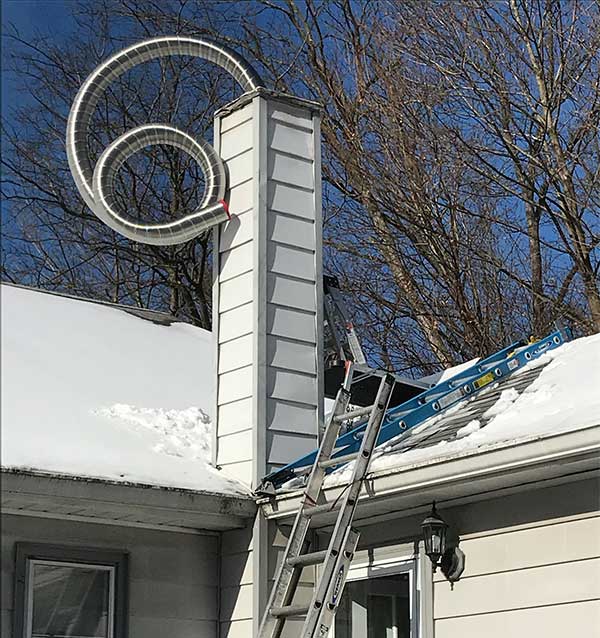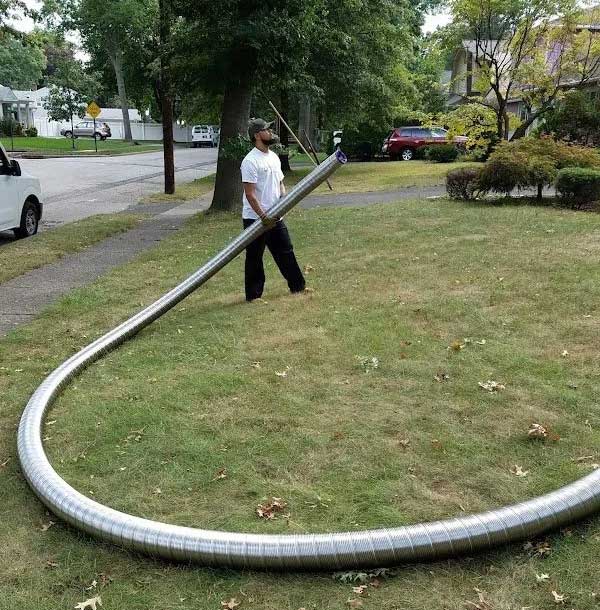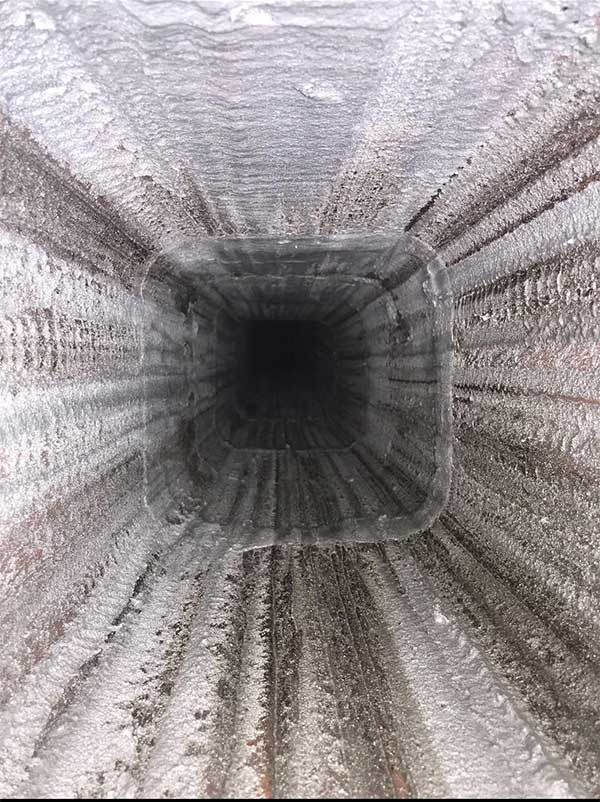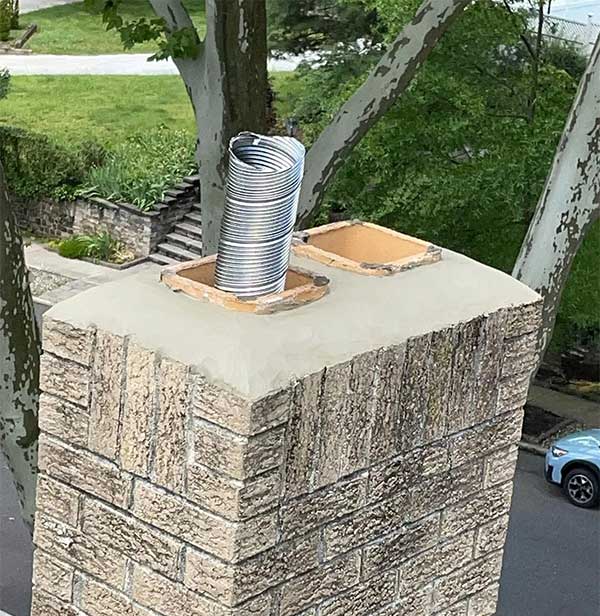Our Chimney Relining Services Offer Quality & Long-Lasting Protection
One of the best ways you can keep your chimney running well and better protected for the long haul is by having a proper liner installed by a Chimney Safety Institute of America (CSIA)-certified technician. Liners play an integral part in keeping your system running safer and more efficiently, and if your chimney is without one (or has a damaged one) it could be putting your home at risk.
The good news for folks living in and near Hillsborough is that the team here at Highpoint Chimney would be happy to help with all of your chimney needs. From relining to reconstruction, chimney cleaning to leak repairs, our highly experienced chimney sweeps can do it all.
What Types of Liners Do We Offer?
We’re proud to offer two types of lining systems for your chimney – stainless steel and HeatShield®.
- Stainless Steel Liners: Our stainless steel liners can be installed quickly, and they offer a lifetime of protection when put in by a pro and regularly maintained. They’re also corrosion-resistant, extremely durable, and bound to keep your household safer than weaker alternatives.
- HeatShield®: There are actually three methods of relining with HeatShield®, and all of them tend to offer a more cost-effective option than having an entirely new stainless steel liner installed. That said, it won’t work for everyone, so consult with us about your options, then we can move forward with the best route.
So, which liner is best for you? You can read up on both of these further down the page, or just reach out to us directly and we can help you figure it out. Our crew would be happy to set you up right.

What Is the Purpose of a Chimney Liner?
Chimney liners are an essential part of any chimney system. In fact, there have been multiple tests completed by industry experts that reveal the dangers of operating unlined chimneys. During these, it was revealed that fire can travel through an unlined chimney, and into the walls of the home, in only a matter of hours.
So, how do they keep your household safer and your chimney running more efficiently?
- They protect the chimney walls from corrosive flue gases. Many different gases and fumes are produced when homeowners burn fuel in their firebox, and these can quickly eat away at the brickwork or clay tiles that make up your chimney walls. Liners prevent that from happening.
- They improve the efficiency of your heating system. When your chimney is lined, it creates a smooth and insulated surface that allows the hot air and gases to flow more freely up and out of your home – guaranteeing you’ll always get the most from your system.
- They lower the risk of experiencing a chimney fire. Increased efficiency and a smoother flow of gases and smoke decreases the amount of creosote that can eventually build up in your chimney – which then minimizes your risk of chimney fires.
- They minimize the risk of harmful fumes entering your home. Smoke, carbon monoxide, and other potentially harmful gases will have much easier access to your home if gaps, cracks, and holes are present throughout your flue. A liner ensures these fumes only move up and out – and not into your living space.

Schedule Appoıntment
Why Are Stainless Steel Chimney Liners a Reliable Choice?
Chimney liners are sometimes offered in a variety of metal types, one being aluminum. Now, the weaker the metal, the cheaper it is – which is why many won’t go with the more costly stainless steel options. Unfortunately, this can invite issues down the line.
Why do we recommend going with stainless steel over other alternatives?
Durable & Strong
Stainless steel liners are well-known for being resistant to damage, rust, and all kinds of other issues. Because of this and their high levels of durability, they can better withstand the harsh conditions that chimneys are known to face – like extreme heat, moisture, exposure to acidic gases, and more.
Corrosion-Resistant
Stainless steel liners are highly resistant to corrosion, which is a common problem in chimneys – particularly in older homes and buildings where the chimney has been in use for many years. Corrosion can weaken the structure of your system, leading to an increased risk of house fires, gas leaks, and other safety hazards. Needless to say, avoiding it at all costs is a must.
Heat-Resistant
Heat-resistance is another important quality all liners should possess. And while weaker metals can resist high temps to an extent, none do it as well as stainless steel. Stainless steel liners are much less likely to become damaged or weakened by exposure to heat, which can help prolong the lifespan of your chimney and reduce the need for repairs or replacement parts down the line.
Easy to Install
Ease of installation is another advantage stainless steel chimney liners have to offer. It’s a process that can be completed swiftly and in less than a day, meaning your household won’t need to be inconvenienced any longer than necessary. Before you know it, your fireplace will be up and running again – all ready for your family to safely enjoy.
Improved Safety
Strength, reliability, durability, heat-resistance, lower chances of corrosion, and stainless steel liners’ many other benefits all contribute to them being the safer option, as well. The better your liner can hold up against heat and damage, the longer it will last, and the more protection it will offer your home and chimney. That means you’ll be less prone to carbon monoxide exposure, smoke inhalation, chimney fires, house fires, and more.
Highly Efficient
When investing in a new liner, you want to know it’s going to help guide smoke, fumes, and other gases up and out of your fireplace as efficiently as possible. Stainless steel options are known for doing the job better than any other.
Lifetime Warranty
If a product comes with a lifetime warranty, then you know it has to be a good one. Stainless steel liners typically offer this benefit, as long as they were installed by a certified professional – like us – and as long as your chimney is regularly serviced. All said, this is a huge benefit that we wouldn’t want you to overlook.
What Does HeatShield® Relining Entail?
With HeatShield®, you’ll have the choice between three methods for relining your chimney: the Joint Repair System, the Resurfacing System, or the CeCure® Sleeve Relining System. And while each of these methods vary, a lot of their processes are quite similar. In addition, all use HeatShield®’s Cerfractory® sealant, which is a specially-formulated mixture used to fill in any gaps, cracks, or openings that are present in a damaged system.
Here’s what you can expect from any HeatShield® relining job:
- An inspection. Our certified sweeps will look your system over, noting any damage or deterioration, so that we can determine the best plan for moving forward. This typically involves a thorough visual examination of the chimney’s interior and exterior.
- A cleaning. Before the relining process can begin, the chimney must be thoroughly cleaned to remove any debris or buildup that might get in the way. During the Resurfacing jobs, we also apply a “tie coat” material, which helps remove any remaining dust in your flue and acts as a primer for the steps ahead.
- An application of the Cerfractory® sealant. All of HeatShield®’s methods require the use of this specially-formulated mix. The application of it is where things start to differ between the three, though. For the Joint Repair System, the sealant simply fills in any gaps and imperfections. For the Resurfacing or CeCure® Sleeve methods, a full ¼” layer is applied.
If you’re having the Joint Repair System or the Resurfacing System done, that’s about all there is to it. The CeCure® Sleeve Relining System requires a couple extra steps, though. With this final method, the tech will install the CeCure® Sleeve, followed by an additional layer of the Cerfractory® Sealant.
Overall, the HeatShield® relining process is designed to provide a durable, effective, and affordable solution for repairing and relining damaged chimney flues. If you think this might be right for you, work with our certified chimney sweeps to further discuss your needs and options.
Schedule Appoıntment

HeatShield
How Often Should My Chimney Liner Be Inspected?
Most industry experts and organizations recommend investing in annual chimney and fireplace inspections. And when you get these scheduled, rest assured your sweep will get a good look at your liner in the process.
Why are annual chimney inspections important? Well, in addition to checking on the liner, our sweeps can also assess the overall structural soundness of the chimney, as well as look for any clogs, buildup, or obstructions. After which, we’ll either give your chimney a good bill of health (allowing you to light fires with ease and peace of mind), or we’ll recommend repair work, so you can safely use your system later on.
All that said, be sure you’re keeping an eye on your system too. If you notice anything unusual, or if you’ve been noting poor performance (like smoke backup, not as much heat, poor airflow, etc.) reach out to us, so that we can look things over. Some hidden damage might be lingering, and it could be putting your household at risk.
How Do I Know if My Chimney Liner Needs To Be Repaired or Replaced?
Curious about which potential signs of damage you, as a homeowner, can watch for in between your professional inspections and regular chimney cleaning services? There are several things that might indicate your liner is in need of repairs – or might need to be replaced entirely.
- Creosote Buildup: If there’s a lot of creosote in your flue, then your liner could be facing damage as a result. And if creosote is forming a lot quicker than seems normal, this is another indicator that your liner isn’t doing its job and may need some professional attention.
- Smoke Backup: Do you deal with smoke in your home every time you light a fire? Or maybe you’re noticing smoke escaping through the masonry walls of your chimney? This is often a sign that your liner is faulty.
- Cracking or Holes: If you spot cracks, holes, or gaps throughout the liner, don’t put your system to use until a chimney professional can take a look. Running your fireplace will only make damages worse, and this could put your system and household at risk.
- Poor Draft/Airflow: A chimney that isn’t drafting properly won’t offer you the heat output you’re hoping for. Liners play a big role in ensuring proper airflow, so this could be why your system is performing poorly.
In addition to all of this, do your best to keep track of how old your liner is. While some models come with a lifetime warranty, other types need to be replaced from time to time. If yours is past due for a replacement, you could easily face corrosion and other hazards.
If you notice any of these signs or have any concerns about the condition of your chimney liner, don’t wait to reach out. We’d be happy to evaluate the condition of the liner and chimney, then recommend the next appropriate course of action.
Can I Install My Chimney Liner Myself?
Like with nearly any big chimney repair job, we don’t recommend attempting to install a new chimney liner yourself. This is a complex job that requires extensive skill and chimney knowledge, so we’d only suggest leaving it to a certified and experienced team of sweeps – like the crew here at Highpoint.
Think of it this way. A properly installed chimney liner can help improve the efficiency and safety of your chimney significantly. On the flip side, a faulty liner can do just the opposite by allowing heat to transfer to surrounding walls and letting fireplace fumes and gases break down your masonry. This isn’t a component to take any chances with.
Attempting this job yourself can also be risky, since it requires working on a ladder or climbing on top of your roof.
We have the expertise and specialized tools and equipment necessary to properly assess your chimney, determine the appropriate liner size and material, and install the liner safely and correctly. We’ll also be able to ensure that the liner meets local building codes and regulations. Don’t trust the job to anyone else – give our experts a call today to schedule.
How Much Do Chimney Relining Services Cost?
There are a lot of things that affect the cost of your chimney relining services, such as the size of your chimney, the type of liner being installed, and the complexity of the installation process.
For the most accurate estimate, we recommended giving the crew here Highpoint a call to discuss your needs and figure out which relining method would be best for your flue. After that, we can get you a more detailed cost estimate for your project.
Is chimney relining typically expensive?
Regardless of the type of liner you want to invest in, you can expect the price point for this type of job to be on the higher end – as opposed to more simple repair jobs, like a cap replacement or some minor tuckpointing work.
It’s important to note, though, that while the cost of installing a chimney liner may seem high, a well-functioning one will provide significant long-term benefits, such as improved efficiency, less risk of damage, increased safety, and more – all of which can offset that initial cost over time. Basically, if a chimney liner prevents a chimney fire or home damage, it’ll be well worth the money spent.
On top of all that, liners are integral for keeping your household better protected and those living inside of it safer – and you can’t put a price on that.
Do Chimney Liners Improve Fireplace Efficiency?
Yes. A properly installed chimney liner helps create a smooth, airtight passage for smoke and fumes to travel through – which can then improve your draft and the overall efficiency of your system significantly. This can also reduce the amount of heat lost while your fires are lit, thus helping to lower your energy bills – another huge plus.
Chimney liners prevent creosote and other buildup from accumulating as quickly in your chimney, which, again, helps improve efficiency – while keeping your system running safer in the process. Your risk of chimney fires will decrease, as will the risk of smoke or carbon monoxide exposure.
In the end, a well-fitted liner isn’t something your chimney can operate well without – and lighting fires when your liner is missing or damaged can put your home and family at risk. Don’t take any chances. Rely on the team here at Highpoint for quality services today.
Call Now

How Long Does a Chimney Liner Last?
The life span of the average chimney liner will vary depending on the type of liner the homeowner invested in, as well as how often the chimney is used and how often the owner invested in professional maintenance. An aluminum liner that experiences a lot of wear, for instance, may only last a decade, while a stainless steel liner should come with a lifetime warranty.
On that same note, a liner that is inspected annually will typically last longer than one that isn’t. These overviews give sweeps the chance to spot minor flaws before they turn into big issues, so you can get them fixed up quickly and get back to using your system with ease and peace of mind.
Essentially, you get what you pay for, so keep all this in mind when considering the best relining method for your needs. If you have any questions, our experts would be happy to help you out.
Who Should I Hire to Install My Chimney Liner?
With something as important as your chimney liner, you’ll want to hire a technician that really knows their stuff. Doing your research and seeking out someone who is experienced and knowledgeable about local building codes and regulations can make all the difference in how well the job is done.
Here are some steps we recommend taking before making any final hiring decisions:
- Ask for recommendations. Many start their search by asking friends, family, and neighbors who they’ve worked with in the past, and who they might recommend. You can also reach out on social media to see who other community members have hired and liked.
- Check qualifications. Keep an open eye for licensing and insurance info, and confirm that your tech has been certified with the Chimney Safety Institute of America (CSIA). This shows a commitment to the trade and a dedication to providing the highest level of care possible.
- Check reviews. Ask the techs you’re hiring for references or check online reviews from previous clients to see how others liked (or disliked) working with them. In today’s world, finding out about other’s experiences is easier than ever – take advantage of it!
- Ask about warranties. Make sure to ask about warranties or satisfaction guarantees, in case there are any issues that pop up later.
- Check into experience. How experienced are the techs you’re hiring? Have they been in the industry for quite some time? If so, this is a good sign that they really know what they’re doing.
Here at Highpoint, we check all the boxes. We’re highly experienced, we put your needs first, and we care about staying educated and up to date on industry news. And, if you check out our reviews, you’ll see that others love working with us. If you need quality care, don’t put it off – reach out to our team of sweeps today.
Give Our Certified Sweeps a Call
Why do so many in Hillsborough and all of the towns, cities, and suburbs surrounding count on us for relining services and chimney repairs? Because we continue proving ourselves time and time again. We value education, and we care about personalizing our services, so that your needs are always met.
So, don’t put it off – if you need a new liner (or a new chimney cap, chase cover, or any other chimney component) installed, turn to our techs for a job done right.
Get started by reaching out online or by calling us at 908-864-4114 now. Thanks for putting your trust in us!
Who knew it could be so efficient to have your dryer vent cleaning and your chimney sweeping done during the same visit with our trained techs?
